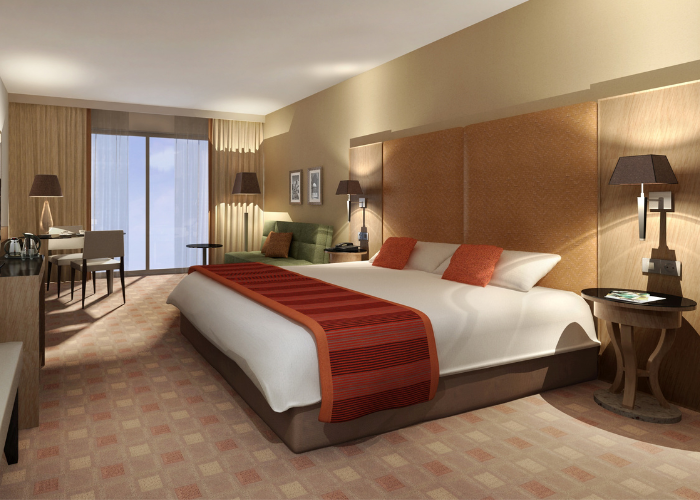The global home improvement market size was valued at around $340.81 billion in 2022. This means there’s potentially a lot of business in home repairs and renovations.
But how do you make your mark in such a saturated industry?
By leveraging technology.
Room rendering allows professionals to communicate their vision—from materials and textures to paint color and lighting—in a language their clients understand (and remember!).
Discover how you can bring them to life with Plus Render.
How Are Room Renderings Different From Other Spaces in the House?
All renderings are not created equal. In room renderings, the focus is on one particular area. As such, photorealistic representation is a powerful tool that highlights the form and function of the space with insane attention to detail.
But wait, it gets better.
Room renderings go beyond floor plan and layout. Unlike renderings of other spaces in the house, room renderings focus on furniture, materials, finishes, fixtures, lighting, shadows, and accents—all of which are carefully selected to create a specific mood or atmosphere.
This interactive tool is often used by interior designers looking to pitch their vision to clients. Once the client signs up for the 3D visualization, they can dedicate their time and resources toward the remodel with greater confidence.
Creating a Wow-Worthy Room Rendering
You’re a pro at designing rooms but how do you take things up a notch and ensure client satisfaction? Here are some tips that will take your design from good to great:
Thoroughly Understand What Your Client Wants
Anyone can design a room but outstanding interior designers begin by thoroughly understanding what their clients want. They ensure complete alignment by conducting diligent pre-project assessments.
This entails holding detailed discussions during client briefings. They ask about their client’s vision, preferences, and lifestyles. They make sure that they have a good grasp of the kind of room that is needed, including how it will be used.
After the briefing, they create mood boards to check if they’re on the same page.
Make Plans for the Space
Next comes the second biggest factor in design renders: layout. Regardless of the design, the space should flow smoothly. People should be able to move around easily without bumping into furniture and unexpected walls.
Depending on the client’s requirements, areas should be sectioned off for various activities. If you need a seating area, consider adding comfortable chaises and a coffee table. Turn it into a reading nook by adding a bookshelf. A window with natural lighting nearby adds a nice touch and encourages people to linger and use the area.
At the same time, select furniture that complements the space and your desired aesthetic. They shouldn’t be too big or too small based on the available space.
Another matter you and your clients could consider is having versatile spaces that can be used in more than one way…
Create Multi-Functional Spaces
In urban areas, square footage is in high demand and expensive. That’s why multi-functional spaces that can host various activities are becoming more popular.
Instead of simply designing a living room, bedroom, or playroom, consider how it can be made more functional for the occupants. Dining rooms can double as workspaces. Guest rooms can also be home offices. And playrooms can serve as a child’s bedroom.
You can create multi-functional spaces with removable dividers, stackable and foldable furniture, area rugs, and lighting. You can also maximize vertical spaces and mount furniture like desks and shelves on the walls.
Select Beautiful, Quality, and Durable Materials
Finishing materials like fabrics and flooring can transform a room. Choose materials that offer durability and quality.
Don’t forget to consider the room’s intended use. If it’s a high-traffic area like a kitchen or a living room, you’ll need to use more durable materials like tile and wood. For areas with fewer people like bedrooms and home offices, more delicate materials like carpets and laminates may be sufficient.
One major trend in interior design is using sustainable materials such as bamboo and reclaimed wood.
Think About Lines
Do you have a space that feels too big or too small? Incorporating the right lines can do wonders. Horizontal lines make the room feel more spacious. Vertical lines offer the illusion of a taller venue. Zigzagging and diagonal lines inspire excitement and vitality. Meanwhile, curved lines highlight movement and create interest.
Make lines work for you. You no doubt already know this but the best designers know how and when to use the tools in their arsenal.
Design Your Lighting
Another aspect that’s often overlooked is lighting. While everyone understands the important role lighting plays in beautifying a room, too many spaces are over- or under-lit. Not paying enough attention to your lighting can detract from an otherwise good design.
Think about adding layers of lighting. Add accent, task, and ambient lighting to build cohesion or highlight certain areas. You may also add dimmer switches to make the space more versatile.
Customize the Room and Add Character
As you know, one of the reasons people prefer working with interior designers is because they can offer greater customization. So, don’t be afraid to design rooms based on your client’s taste and personality.
Think about adding bespoke furniture that have been designed to complement and fit specific spaces. Add decor and artwork that reflects your client’s style. Incorporate one-of-a-kind statement pieces that can become conversation starters.
Use Technology To Your Advantage
Nowadays, technology-enabled homes are becoming more common, affordable, and reliable. So, why not use technology to enhance the convenience and features of a room?
Doors can be locked and unlocked with special codes and biometrics. Heating and ventilation systems can be adjusted and switched on/off through apps. Appliances like TVs, washers, and refrigerators can be operated remotely.
These small touches can make a big difference, especially if your client is open to smart homes and their potential.
Consider Storage
People want rooms that they can see themselves living in. Help them engage with your space by providing storage solutions like cabinets, shelves, and drawers. Spacious rooms can have walk-in closets and separate drawers for different accessories while smaller rooms would do well with built-in cabinets and under-bed storage.
Storage is important for reducing clutter, keeping personal items organized, increasing property value, improving functionality, and supporting the lifestyle needs of a room’s inhabitants. When storage is well-designed, it adds to the beauty of a room and makes it more livable.
Think about the function of the room, the people who will be staying there, the items that will be placed inside it, and how many occupants it will have. This will allow you to offer adequate storage space.
You Can Also Use Other Types of 3D Visualizations….
The global 3D rendering and visualization market was worth $2.69 billion in 2023 and is expected to exhibit a compound annual growth rate of 19.9% between 2023 and 2030.
The reason for its increasing popularity?
Its ability to showcase products and properties in visually pleasing ways through various perspectives and camera compositions. But the possibilities don’t end with three-dimensional rendering.
Here’s a look into technologies you can leverage to showcase your design work.
3D Walkthroughs
Instead of verbally pitching your vision, bridge the gap with a 3D walkthrough. This interactive tool is a revolutionary way to provide a near-exact representation of any space. Clients can move around the room—taking stock of the material and finishes used, the furniture installed, and the artwork on the walls—before paying big money.
It’s meant to provide a deep understanding of the environment and what it’s like to walk through it.
Virtual Tour
Did you know that 67% of home buyers want a virtual tour when looking at a listing? It engages the client’s imagination with its immersive effect, which can also include descriptive text and sound to create a specific mood. This allows prospective clients and investors to explore the room, see whether it matches their expectations, and suggest modifications.
Augmented Reality (AR) and Virtual Reality (VR) have further bridged the gap between digital and physical realms, allowing viewers to interact with the room from miles away, through their preferred communication channel.
Panorama 360-Degree View
Let clients experience a room from different angles with an engaging and sophisticated panoramic 360-degree view. You can rotate the image, go from left or right, move between different rooms, look up and down, and even zoom in and zoom out to focus on specific details.
Plus, you can easily share or embed it on your site—perfect for marketing.
Visualize Your Space With Plus Render
Whether you’re an architect or an interior designer, room rendering can be a powerful visualization tool. Let your clients fully appreciate the spaces you’ve designed by entrusting your rendering needs to Plus Render.
With our expert team, advanced hardware, and modeling software—your designs are in good hands. With meticulous attention to detail, professional customer service, and planning, we develop life-like renders for any room you’ve been asked to design.
We can highlight its versatility, intelligent design, functionality, and aesthetics based on your precise requirements.
Book a call with us to learn more.







